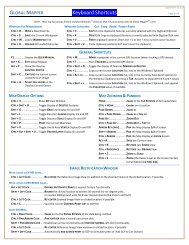Map GPS Coordinates - GPS Map Coordinates ... - Global Mapper
Map GPS Coordinates - GPS Map Coordinates ... - Global Mapper
Map GPS Coordinates - GPS Map Coordinates ... - Global Mapper
You also want an ePaper? Increase the reach of your titles
YUMPU automatically turns print PDFs into web optimized ePapers that Google loves.
<strong>Global</strong> <strong>Map</strong>per User's Manual<br />
Most built-in types already have a default zoom scale at which they will show up in built MP maps (this will<br />
translate to a Levels= value for the feature in the exported MP file based on the levels in the MP file header).<br />
For custom types and for types that you want to change the default zoom scale for, you can add a<br />
MP_BIT_LEVEL attribute to the feature itself or to the default attribute list for a feature type. The value of<br />
this attribute should specify the minimum MP zoom bit level that a feature should appear at. For example, if<br />
you use the maximum <strong>Map</strong> Detail setting with no template file, you will get a map with populated zoom<br />
levels at 24, 22, and 20 bits. If you wanted a feature to show up in just the lower 2 zoom levels of that map<br />
(the 24 and 22 bit resolution layers), you could add a MP_BIT_LEVEL attribute with a value of 22 to your<br />
feature or the default attribute list for that type, then that feature would get a Levels=2 value written to the<br />
exported MP file. If your map had less detail (say zoom levels of 21, 19, and 17 bits), the same feature would<br />
only show up in the most detailed 21 bit layer as features are always present in at least one layer of the map. If<br />
you want a feature to always show up at all zoom levels in your map regardless of what zoom levels are<br />
present, just add a MP_BIT_LEVEL attribute with a value of 1.<br />
The Template File sections allows you to select a file to use as a template for the new MP file. The new file<br />
with use all of the settings from the selected template file except for the map ID (unless you check the Keep<br />
Image ID from Template MP File option) and, if you provide a map name, the map name. This includes the<br />
Dictionary setting and all levels settings. This provides a way for advanced users to set up one MP file exactly<br />
how they want and then export new maps with the same settings. You can also check the Copy Entire<br />
Contents of Template File option to have everything from the template file copied to the new file verbatim,<br />
including any feature data in the template file.<br />
If selected, the Create as Marine <strong>Map</strong> option specifies that the created MP file will be marked as a marine<br />
map and marine features will be used if appropriate. Note that the Marine version of c<strong>GPS</strong><strong>Map</strong>per is required<br />
to create marine maps.<br />
The Make All Point Features Searchable controls whether or not all point features in the final map created<br />
from the MP file should be searchable on the <strong>GPS</strong> device. If the Create Transparent <strong>Map</strong> option is selected<br />
the map will be marked as transparent and any data under the map will show through.<br />
When <strong>Global</strong> <strong>Map</strong>per exports loaded vector data to a MP file, it will automatically attempt to determine the<br />
best type to save in the MP file based on the classification of the feature in <strong>Global</strong> <strong>Map</strong>per. If no type mapping<br />
is known, the name of the assigned <strong>Global</strong> <strong>Map</strong>per classification will be used for the 'Type' value in the MP<br />
file. If you updated your RgnTypes.txt file in your c<strong>GPS</strong><strong>Map</strong>per folder with the type names and the<br />
appropriate type number, you can make this work as well. You can also manually specify the type number to<br />
use for a feature by adding an attribute named MP_TYPE with the type value to use as the attribute value. If<br />
the value that you provide is for a marine type you should also provide an attribute with a name of MARINE<br />
and a value of Y. You can also override the default type mapping for built-in types by adding a default<br />
attribute list for the type on the * Styles tab of the Configuration dialog. Just add a MP_TYPE attribute to the<br />
default attribute list for a type to manually specify what type to use in exported MP files for a given <strong>Global</strong><br />
<strong>Map</strong>per type.<br />
<strong>Global</strong> <strong>Map</strong>per will automatically convert exported data to the appropriate projection and datum for export so<br />
that the Polish MP file will be correctly positioned. By default this will be lat/lon degrees with the WGS84<br />
datum, although if you use a template file that specified a different recognized datum, <strong>Global</strong> <strong>Map</strong>per will<br />
instead convert to that datum automatically. In any case, <strong>Global</strong> <strong>Map</strong>per will always automatically do the right<br />
thing.<br />
Advanced Users: If you aren't use a template to configure your export, you can customize the values used for<br />
several settings in the header for adding registry keys. The following values are supported:<br />
<strong>Map</strong> <strong>GPS</strong> <strong>Coordinates</strong> - <strong>GPS</strong> <strong>Map</strong> <strong>Coordinates</strong> - <strong>GPS</strong><strong>Coordinates</strong> <strong>Map</strong> 67







